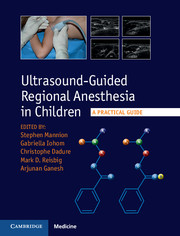Book contents
- Frontmatter
- Contents
- List of contributors
- 1 Introduction
- Section 1 Principles and practice
- Section 2 Upper limb
- Section 3 Lower limb
- Section 4 Truncal blocks
- Section 5 Neuraxial blocks
- 18 Ultrasound-guided epidural anesthesia
- 19 Ultrasound for spinal anesthesia
- 20 Ultrasound-guided caudal block
- Section 6 Facial blocks
- Appendix: Muscle innervation, origin, insertion, and action
- Index
- References
18 - Ultrasound-guided epidural anesthesia
from Section 5 - Neuraxial blocks
Published online by Cambridge University Press: 05 September 2015
- Frontmatter
- Contents
- List of contributors
- 1 Introduction
- Section 1 Principles and practice
- Section 2 Upper limb
- Section 3 Lower limb
- Section 4 Truncal blocks
- Section 5 Neuraxial blocks
- 18 Ultrasound-guided epidural anesthesia
- 19 Ultrasound for spinal anesthesia
- 20 Ultrasound-guided caudal block
- Section 6 Facial blocks
- Appendix: Muscle innervation, origin, insertion, and action
- Index
- References
Summary
Clinical use
In infants and children, epidural analgesia has been proven to be a major component of the multimodal approach to perioperative pain management. Most commonly used in combination with general anesthe-sia, the benefits of epidural anesthesia/analgesia include a reduction of the surgical stress response, decreases in the consumption of intraoperative hypnotic agents and opioids, and the clinical impact of these reductions on post-operative ventilatory function. After surgery, the potential advantages of epidural analgesia include improved comfort with excellent pain control. This facilitates earlier extuba-tion, improved gut function, and more rapid recovery (Walker and Yaksh, 2012; Goeller et al., 2014). Additionally, the reduction in the dose of general anes-thetic agents may be desirable, particularly in infants and neonates, given the concerns regarding their potential neurotoxicity recently raised in the pediatric literature (Sinner et al., 2014). The main perioperative indications of epidural anesthesia/analgesia are major thoracic, abdominal and urologic procedures, spinal surgeries, and complex or bilateral lower limb surgeries. Outside of the operative room, the use of epidural blockade is now also well reported for chronic pain relief, such as pain associated with burns, sickle cell crisis, malignancies, or complex regional pain syndrome (Dadure et al., 2013). As with any other regional anesthesia technique, side effects may be related to placement of the needle and catheter, to the infused drugs, or to the physiologic effects of the medication. The potential list of complications of epidural anesthesia in children is the same as those in adults. However, the incidence of serious (<1:10 000) or major (<1:100 000) incidents appears rarer and less frequent than in adults. Most adverse events reported are minor technical incidents, such as catheter-related problems (dislodgement, leakage, occlusion, or disconnection), or predictable effects, such as urinary retention and other effects associated with opioid adjuvants. Fortunately major neurologic complications are extremely rare, but infections associated with epidural catheters should always be monitored for, particularly in children at risk. Overall the infection rate is low, but prolonged use of a continuous catheter technique (>5 days) is likely to increase this risk (Sethna et al., 2010). Regarding orthopedic surgery, a recent editorial suggested that post-operative epidural analgesia does not delay the diagnosis of compartment syndrome (Johnson and Chalkiadis, 2009).
- Type
- Chapter
- Information
- Ultrasound-Guided Regional Anesthesia in ChildrenA Practical Guide, pp. 125 - 130Publisher: Cambridge University PressPrint publication year: 2015



